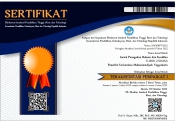Faktor Penyebab Cyberbullying yang Dilakukan oleh Remaja di Kota Yogyakarta
DOI:
https://doi.org/10.18196/jphk.1210Abstract
Penelitian ini dilakukan untuk mengetahui faktor penyebab terjadinya cyberbullying di Kota Yogyakarta. Jaringan internet berupa media sosial, game online, dan media komunikasi digital lainnya dewasa ini telah menjadi fasilitas bagi terjadinya cyberbullying yang dilakukan oleh remaja di Kota Yogyakarta. Kasus cyberbullying yang dilakukan oleh remaja terus meningkat setiap tahunnya. Maka penting kiranya untuk mengetahui faktor penyebab remaja melakukan cyberbullying. Sehingga diharapkan dengan mengetahui faktor penyebab yang memengaruhi remaja melakukan cyberbullying, kita dapat mengetahui kebijakan kriminal (criminal policy) yang tepat guna memberantas cyberbullying secara lebih efektif. Penelitian yuridis empiris ini menggunakan sumber data primer dan sekunder. Hasil penelitian ini menunjukan bahwa faktor yang menyebabkan remaja melakukan cyberbullying di Kota Yogyakarta antara lain: pesatnya perkembangan teknologi, ketidaktahuan remaja akan risiko hukum, perilaku remaja yang suka meniru, serta telah melemahnya kontrol sosial.
Kata kunci: criminal policy, cyberbullying, remaja.
References
Buku:
Dey Ravena, Kristian, (2017), Kebijakan Kriminal (Criminal Policy), Jakarta, Kencana.
Maskun, (2014), Kejahatan Siber (Cyber Crime): Suatu Pengantar, Jakarta, Prenada Media Group.
Muhammad Mustofa, (2015), Metodologi Penelitian Kriminologi, Jakarta, Kencana.
Mukti Fajar, Yulianto Achmad, (2017), Dualisme Penelitian Hukum Normatif & Empiris, Yogyakarta, Pustaka Pelajar.
Peter Mahmud Marzuki, (2011), Penelitian Hukum, Jakarta, Prenadamedia.
Paulus Hadisuprapto, (2016), Juvenile Delinquency: Pemahaman dan Penangunangannya, Bandung, PT. Citra Aditya Bakti.
Ronny Hanitijo Soemitro, 1995, Metodologi Penelitian Hukum dan Jurimetri, Jakarta, Ghalia Indonesia.
Soerjono Soekanto, (2012), Pengantar Penelitian Hukum, Jakarta, UI Press.
Soetandyo Wignjosoebroto, (2013), Hukum Konsep dan Metode, Malang, Setara Press.
Sudarsono, (2015), Kenakalan Remaja: Prevensi, Rehabilitasi, dan Resosialisasi, Jakarta, Rineka Cipta.
Artikel Jurnal:
Catherine D. Marcum, 2009, George E. Higgins, “Examining the Effectiveness of Academic Scholarship on the Fight Against Cyberbullying and Cyberstalking”, American Journal of Criminal Justice, 11(2).
Richard Donegan, 2012, “Bullying and Cyberbullying: History, Statistics, Law, Prevention and Analysis”, The Elon Journal of Undergraduate Research in Communications, 1(3).
Sameer Hinduja, Justin W. Patchin, 2008, “Cyberbullying: An Exploratory Analysis of Factors Related to Offending And Victimization”, Deviant Behavior, 11(3).
Publikasi Instansi:
Asosiasi Penyelenggara Jasa Internet Indonesia (APJII), “Laporan Survei Penetrasi & Profil Prilaku Pengguna Internet Indonesia,” Polling Indonesia, (April, 2019).
Reno Mardina, “Kekerasan Terhadap Anak dan Remaja” Infodatin, (Juni, 2019).
Internet:
Wikipedia, (2019), Daftar Negara Menurut Jumlah Pengguna Internet, Available online from: https://id.wikipedia.org/wiki/Daftar_negara_menurut_jumlah_pengguna_Internet, . [Accessed October 17, 2019].
Downloads
Published
Issue
Section
License
Copyright statementAuthors who publish with JURNAL PENEGAKAN HUKUM DAN KEADILAN agree to the following terms:
- Authors retain copyright and grant the journal right of first publication with the work simultaneously licensed under a Creative Commons Attribution License that allows others to share the work with an acknowledgement of the work's authorship and initial publication in this journal.
- Authors are able to enter into separate, additional contractual arrangements for the non-exclusive distribution of the journal's published version of the work (e.g., post it to an institutional repository or publish it in a book), with an acknowledgement of its initial publication in this journal.
- Authors are permitted and encouraged to post their work online (e.g., in institutional repositories or on their website) prior to and during the submission process, as it can lead to productive exchanges, as well as earlier and greater citation of published work (See The Effect of Open Access).
- Share — copy and redistribute the material in any medium or format
- Adapt — remix, transform, and build upon the material
- Attribution — You must give appropriate credit, provide a link to the license, and indicate if changes were made. You may do so in any reasonable manner, but not in any way that suggests the licensor endorses you or your use.
- NonCommercial — You may not use the material for commercial purposes.
- ShareAlike — If you remix, transform, or build upon the material, you must distribute your contributions under the same license as the original.
- No additional restrictions — You may not apply legal terms or technological measures that legally restrict others from doing anything the license permits.

JPHK is licensed under a Creative Commons Attribution-NonCommercial-ShareAlike 4.0 International License.

